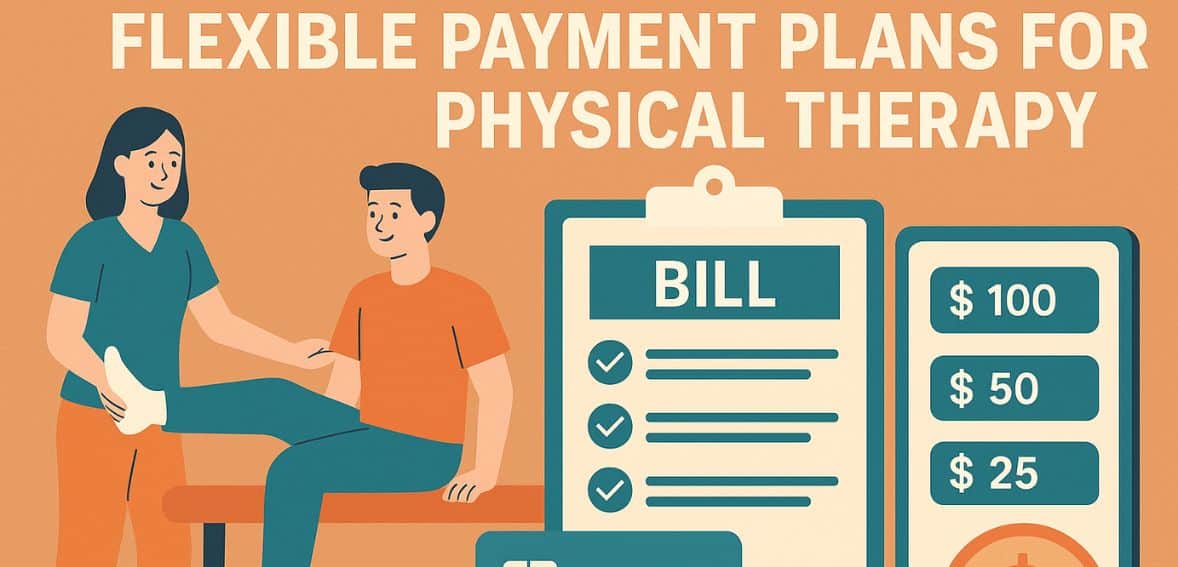
By Emilia Vengor July 17, 2025
The cost of physical therapy can be prohibitively high for many patients, particularly if their insurance does not fully cover the recommended course of treatment. Multiple sessions, consistent co-pays, or even out-of-pocket costs for supplies and aftercare are common in therapy. Patients might put off necessary rehabilitation if they don’t have flexible financing options, which could prolong their recovery or make their conditions worse. Clinics can eliminate financial obstacles and maintain patient engagement in their’ treatment journeys by implementing payment plans that are customized to each patient’s needs.
Understanding the Spectrum: What Payment Plans Really Mean

Simple in-office installment plans and third-party financing with interest-free promotional tiers are examples of flexible payment options. While some clinics work with providers like CareCredit or Wells Fargo Health Advantage, who take on the risk and pay clinics up front, others offer sliding-scale models based on income. Internal plans can be effective, but they come with a default risk and need strict administrative oversight. However, third-party plans relieve the staff of the burden of collections and bad debt exposure, even though they may include service fees for the clinic.
What Doesn’t Work: Common Pitfalls and Practical Struggles
Plans that are manually managed internally frequently fail. Large numbers of missed payments—as well as additional administrative expenses—may result from practices that depend on employees to manually process recurring payments or send reminders. Cash flow issues and workforce inefficiencies are caused by noncompliant patients who have past-due balances.
Furthermore, patients may completely withdraw from enrollment if credit checks are required or if the tiers are unclear. When payment plans are not fully explained at intake, practices also falter. Patients feel taken by surprise when terms are presented through complicated paperwork or hidden in fine print. Retention and satisfaction both suffer when there are ambiguous expectations or unexpected costs.
Leveraging Third-Party Financing: Pros and Cons
Collaborating with outside funding sources is successful for many clinics. These outside services usually handle payment collection, finance the patient, and promptly reimburse the clinic. While the clinic avoids carrying bad debt, patients benefit from flexible terms like extended repayment plans or zero-interest loans.
These routes do have trade-offs, though. Some patients are reluctant to establish a third-party credit relationship, and processing fees can lower net revenue per patient. When assessing these services, clinics have to weigh the upfront financial impact against patient access.
Integrating Technology: Patient Portals, Automation, and Analytics

The success of payment plans is enhanced by modern technology. Easy access to account information, payment plans, and previous statements is provided by integrated patient portals. Patients can pay at any time using desktop computers or mobile devices, which greatly increases the likelihood of adherence.
Clinics can decrease staff time spent on collections while increasing patient transparency by implementing automated reminders, recurring billing, and analytics tools. Ensuring that these tools align with PCI compliance in physical therapy payment processing is essential to safeguard sensitive patient payment data and avoid legal complications.
Balancing Empathy and Financial Viability
Although flexibility promotes goodwill, clinics also need to safeguard their cash flow. Clinics can customize options without jeopardizing their financial stability by providing a range of tiers, from income-based no-interest options to premium, longer-term plans. Discounted upfront packages or early payoff incentives can promote quick repayment while preserving revenue predictability. Clinics can improve their offerings over time by learning from payment trends and data collection.
Strengthening Patient Trust Through Transparent Communication

The trust built between the patient and the physical therapist is one of the most important factors in determining whether a flexible payment plan will be successful. Even the most flexible plan may feel burdensome to a patient if they perceive hesitation, unclear payment expectations, or hidden terms. Transparency is therefore ,not only a good idea, but also necessary.
Clarity regarding payment options should be incorporated into the conversation from the moment a patient enters the clinic or makes an online appointment. This does not entail presenting patients with bills right away; rather, it entails demonstrating an interest in learning about their financial circumstances and helping them find solutions.
When patients believe that their providers view them as more than just payers, they react favorably. This transparency builds long-term relationships, especially when patients undergo extended care and need assurance that cost won’t become a source of stress or interruption.
Technology as a Tool for Simplicity and Efficiency
The administrative complexity is one of the main reasons why many physical therapy clinics are reluctant to offer flexible payment plans. It is ineffective and error-prone to manually manage installment dates, send reminders, and reconcile partial payments. However, these issues can be handled—even automated—with the correct software.
These days, practice management systems come with integrated payment modules that include digital signatures, automated reminders, and recurring billing. To cut down on errors and friction, patients can receive text or email confirmations and set up auto-pay options. This means less time spent chasing down unpaid balances and quicker reconciliation for the clinic.
Better forecasting is another benefit; clinics can more confidently handle payroll, rent, and reinvestment when they know how much cash flow will arrive over month. These systems, while an upfront investment, often pay off quickly by reducing billing disputes and freeing up staff time for patient care.
Customization Over One-Size-Fits-All Plans
Offering identical payment plans makes little sense because no two patients have the same treatment plan. For this reason, the most prosperous clinics frequently take a customized approach to flexible payments. Offering variations based on patient need can be very beneficial, even though there may be default options like “pay in four” or monthly installments.
Lower payments over a longer period may be advantageous for a patient recuperating from a serious injury with a lengthy rehabilitation period. On the other hand, a person with short-term treatment objectives might choose a shorter repayment plan. Giving patients options empowers them and lowers the likelihood of default.
Clinics that are successful in putting this model into practice typically assign a staff member who has been trained in financial discussions, not to coerce the patient, but to politely discuss options. Patients are more likely to adhere to financial commitments and remain involved in their care when they believe that the plan was developed with them, not for them.
Aligning Payment Plans with Insurance Timing

Insurance frequently either does not cover all physical therapy treatments or does so after a delay. Both the patient and the clinic experience a financial gap as a result of this reimbursement delay. Astute clinics foresee this and create payment schedules that correspond with the cycles of insurance processing.
A payment plan could be set up to start in earnest after the 30-days, for example, if insurance is supposed to reimburse within that time frame. In this manner, patients who are anticipating coverage are spared from having to pay out of pocket. Proactive communication between billing departments and patients is necessary for this kind of alignment, but when done correctly, it reduces misunderstandings, raises patient satisfaction, and prevents redundant billing attempts.
Additionally, it shows a greater comprehension of patients’ realities, gaining their trust in the process.
Training Staff for Financial Conversations
Clinics frequently underestimate the importance of educating patient coordinators and front desk employees about financial matters. In actuality, these employees are at the forefront of financial communication. A plan’s acceptance or rejection may depend on how it presents a payment plan, responds to inquiries, or handles a patient’s concerns.
Just as crucial as teaching employees how to properly explain payment terms is training them in soft skills like empathy, active listening, and conflict de-escalation. Just as crucial as teaching employees how to properly explain payment terms is training them in soft skills like empathy, active listening, and conflict de-escalation.
They must be self-assured but sympathetic, providing assistance without causing discomfort. Patients are more likely to stick with their treatment and payment obligations when they believe the clinic is courteous and supportive. A clinic that invests in this type of training demonstrates that it values patient dignity and understands the complex emotions that often accompany financial conversations.
Why Metrics Matter in Payment Plan Success
Flexible payment plans are strategies that should be evaluated similarly to other aspects of a clinic’s performance, not just financial instruments. You can gain a true understanding of what’s effective by monitoring patient retention, collection cycles, default rates, and satisfaction ratings related to patient financing options. It is impossible to determine whether your altruistic policies are profitable or a waste of money without data.
By keeping an eye on these metrics, clinics can make real-time adjustments, such as modifying automation rules, modifying plan durations, or changing the way options are displayed to patients. Stronger patient relationships and improved systems are the results of this analytical approach over time.
Conclusion: A Patient-Centered Approach to Financial Flexibility
In the end, the goal of implementing flexible payment plans in a physical therapy setting is not just to collect revenue, but to keep care accessible while maintaining the clinic’s financial health. The best systems support both sides of the equation, and patients are more likely to follow through on their therapy and payments when they feel heard, respected, and supported.
To do this, clinics must move beyond basic transactional models and embrace financial planning as part of patient care, which entails using technology, training staff, providing customization, and communicating clearly and empathetically.